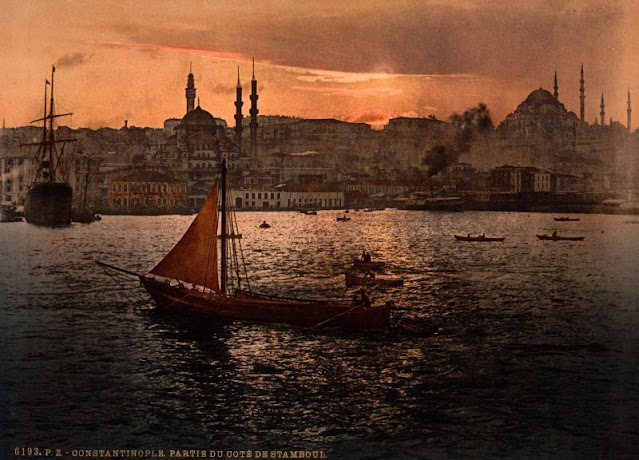These postcards of the capital (then known as Constantinople) of the Ottoman Empire at the close of the 19th century were produced using the Photochrom process. The technique applies layers of artificial color to a black and white image with surprisingly realistic results.
Photochrom was developed in the 1880s by an employee of a Swiss printing company and involves coating a lithographic limestone tablet with a photosensitive emulsion and exposing it to light under a photo negative.
In 1923, after the Turkish War of Independence, Ankara replaced the city as the capital of the newly formed Republic of Turkey. In 1930, the city's name was officially changed to Istanbul. Take a look back at the city through these 21 stunning Photochrom postcards:
 |
| Galata Bridge and a view of Pera |
 |
| Constantinople |
 |
| A mosque and street market |
 |
| The fountain of Sultan Ahmed |
 |
| The Yeni Cami by moonlight |
 |
| The neighborhood of Fenerbahçe |
 |
| A cook in the Rue de Stamboul |
 |
| The Bosphorus, Rumeli and Anadali-Hissar |
 |
| Galata Bridge |
 |
| Dolmabahçe Palace |
 |
| Near the Seraskerat (Ministry of War) |
 |
| The district of Scutari |
 |
| The Koca Sinan Pasha complex |
 |
| Barbers near Seraskerat |
 |
| Imperial gate, Topkapi Palace |
 |
| The Golden Horn waterway |
 |
| Cypresses along the road to the cemetery |
 |
| Part of the Eyoub (i.e., Uyüp) cemetery, I |
 |
| Yeni Cami mosque and Eminönü bazaar |
 |
| The Scutari district |
 |
| The harbor of Constantinople |
(via Library of Congress, Mashable)








0 comments:
Post a Comment